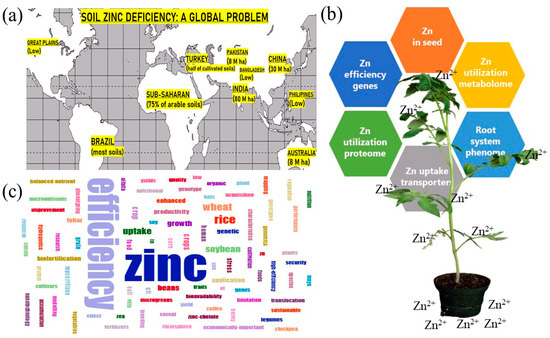- Subjects: Agriculture, Dairy & Animal Science
- |
- Contributor:
- G. Hacisalihoglu
- zinc
- sustainability
- food security
- seed quality
- zinc efficiency
- staple foods
- crops
This video is adapted from 10.3390/plants9111471
It is estimated that global food crop production must double in order to feed the increased world population of 10 billion by the year 2050 [1][2][3][4][5][6][7][8][9][10]. Zinc (Zn) deficiency, together with vitamin A and iron (Fe) deficiencies, are the most common nutritional disorders, especially in developing countries [2]. Research shows that 17.3% of people worldwide are at Zn deficiency risk [3]. Zn is one of the 17 essential mineral nutrients and plays an important role in plant growth, function, gene expression, structures of enzymes, photosynthesis, pollen development, sugar transformation, protein synthesis, membrane permeability, signal transduction, and auxin metabolism [4][5][6]. Plants take up the Zn from the soil and soil Zn deficiency has become a critically important abiotic stress factor, affecting over 49% of arable lands worldwide (Figure 1a) [5][6][7][8]. Zn deficiency negatively affects plant growth, causing stunting short internodes, small leaves, and interveinal leaf chlorosis, as well as delayed maturity and necrotic tissue death in severe cases [4]; therefore, adequate Zn is essential for crop yield and quality. Moreover, the use of synthetic fertilizers is often insufficient to alleviate soil Zn deficiency.

Figure 1. Overview of Zn deficiency and plant Zn efficiency. (a) Zn deficiency world map showing major countries and regions with low-Zn soils; (b) potential plant Zn efficiency approaches; and (c) word cloud of plant Zn efficiency keywords from the literature.
In order to reduce Zn deficiency throughout the susceptible regions, research has been conducted in various countries that are low in Zn, such as Turkey, Australia, Brazil, India, and China [8][9][10][11]. Plants with high Zn efficiency exhibit high yield and significant growth under low Zn supply [9]. Identifying, developing, and growing Zn-efficient crop varieties could provide approaches for managing low-Zn stress in soils to minimize yield and quality losses [4]. Moreover, elucidating the mechanisms of Zn efficiency will provide important information for improving crop nutrition, as well as sustainable global food systems [4][8][11].
Zn is also essential for human nutrition and development, therefore highlighting the importance of improved Zn contents in staple food crops such as rice, wheat, maize, beans, and others [12]. Understanding the mechanisms of Zn transport and distribution within crops could inform efforts to improve the Zn content of key foods. For example, an effective approach in recent years is biofortification (biological fortification), enriching crops using transgenic techniques, agronomic practices, or conventional crop breeding, which offers sufficient levels of Zn via cereals, vegetables, beans, and fruits to the targeted regions worldwide [13].
- FAO. FAO Statistical Databases. Available online: http://apps.fao.org/ (accessed on 20 September 2020).
- Welch, R.M.; Graham, R.D. Agriculture: The real nexus for enhancing bioavailable micronutrients in food crops. J. Trace Elem. Med. Biol. 2005, 18, 299–307. [Google Scholar] [CrossRef]
- Wessels, K.R.; Brown, K.H. Estimating the global prevalence of zinc deficiency: Results based on zinc availability in national foods supplies and prevalence of stunting. PLoS ONE 2012, 7, e50568. [Google Scholar] [CrossRef] [PubMed]
- Marschner, H. Mineral Nutrition of Higher Plants; Academic Press: London, UK, 1995; p. 889. [Google Scholar]
- Alloway, B.J. Soil factors associated with zinc deficiency in crops and humans. Environ. Geochem. Health 2009, 31, 537–548. [Google Scholar] [CrossRef] [PubMed]
- Hacisalihoglu, G.; Kochian, L.V. How do some plants tolerate low levels of soil zinc? Mechanisms of zinc efficiency in crop plants. New Phytol. 2004, 159, 341–350. [Google Scholar] [CrossRef]
- Hacisalihoglu, G.; Blair, M. Current advances in zinc in soils and plants: Implications for zinc efficiency and biofortification studies. Achiev. Sustain. Crop Nutr. 2020, 76, 337–353. [Google Scholar]
- Hacisalihoglu, G.; Hart, J.J.; Kochian, L.V. High and low affinity Zn transport systems and their possible role in Zn efficiency in bread wheat. Plant Physiol. 2001, 125, 456–463. [Google Scholar] [CrossRef]
- Cakmak, I.; Torun, B.; Erenoglu, B.; Oztürk, L.; Marschner, H.; Kalayci, M.; Ekiz, H.; Yilmaz, A. Morphological and physiological differences in the response of cereals to zinc deficiency. Euphytica 1998, 100, 349–357. [Google Scholar] [CrossRef]
- Hacisalihoglu, G.; Ozturk, L.; Cakmak, I.; Welch, R.M.; Kochian, L.V. Genotypic variation in common bean in response to Zn deficiency in calcareous soil. Plant Soil 2004, 259, 71–83.
- Broadley, M.R.; White, P.J.; Hammond, J.P.; Zelko, I.; Lux, A. Zinc in plants. New Phytol. 2007, 173, 677–702. [Google Scholar] [CrossRef]
- Grusak, M.A.; DellaPenna, D. Improving the nutrient composition of plants to enhance human nutrition and health. Annu. Rev. Plant Biol. 1999, 50, 133–161. [Google Scholar] [CrossRef]
- Cakmak, I. Enrichment of cereal grains with zinc: Agronomic or genetic biofortification. Plant Soil 2008, 302, 1–17.
